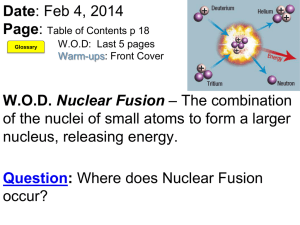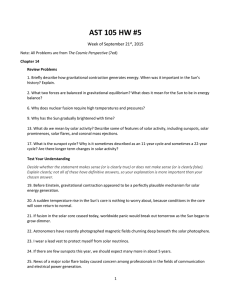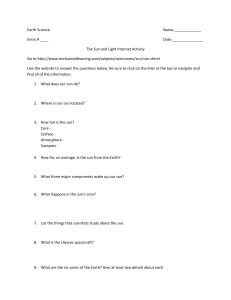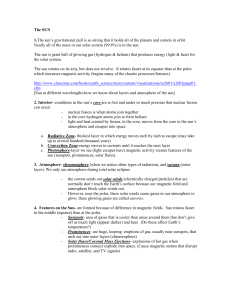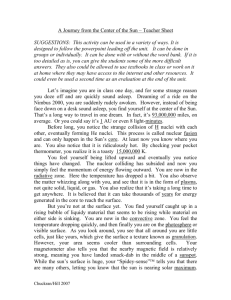AST 105 HW #5 Solution Week of September 21 , 2015
advertisement
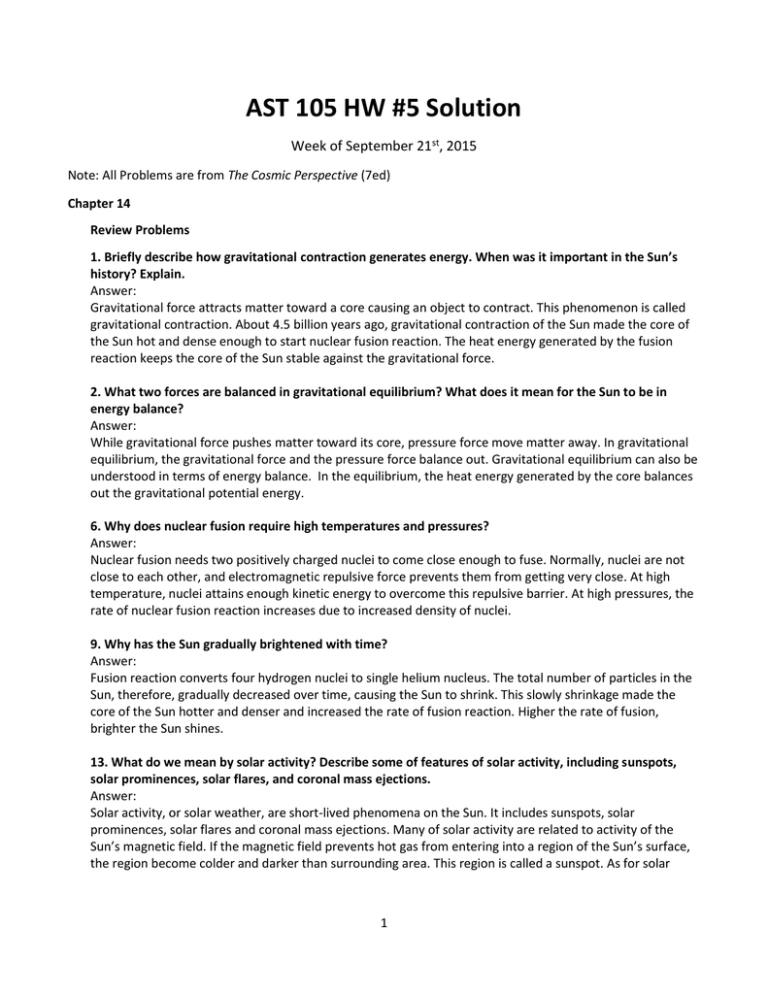
AST 105 HW #5 Solution Week of September 21st, 2015 Note: All Problems are from The Cosmic Perspective (7ed) Chapter 14 Review Problems 1. Briefly describe how gravitational contraction generates energy. When was it important in the Sun’s history? Explain. Answer: Gravitational force attracts matter toward a core causing an object to contract. This phenomenon is called gravitational contraction. About 4.5 billion years ago, gravitational contraction of the Sun made the core of the Sun hot and dense enough to start nuclear fusion reaction. The heat energy generated by the fusion reaction keeps the core of the Sun stable against the gravitational force. 2. What two forces are balanced in gravitational equilibrium? What does it mean for the Sun to be in energy balance? Answer: While gravitational force pushes matter toward its core, pressure force move matter away. In gravitational equilibrium, the gravitational force and the pressure force balance out. Gravitational equilibrium can also be understood in terms of energy balance. In the equilibrium, the heat energy generated by the core balances out the gravitational potential energy. 6. Why does nuclear fusion require high temperatures and pressures? Answer: Nuclear fusion needs two positively charged nuclei to come close enough to fuse. Normally, nuclei are not close to each other, and electromagnetic repulsive force prevents them from getting very close. At high temperature, nuclei attains enough kinetic energy to overcome this repulsive barrier. At high pressures, the rate of nuclear fusion reaction increases due to increased density of nuclei. 9. Why has the Sun gradually brightened with time? Answer: Fusion reaction converts four hydrogen nuclei to single helium nucleus. The total number of particles in the Sun, therefore, gradually decreased over time, causing the Sun to shrink. This slowly shrinkage made the core of the Sun hotter and denser and increased the rate of fusion reaction. Higher the rate of fusion, brighter the Sun shines. 13. What do we mean by solar activity? Describe some of features of solar activity, including sunspots, solar prominences, solar flares, and coronal mass ejections. Answer: Solar activity, or solar weather, are short-lived phenomena on the Sun. It includes sunspots, solar prominences, solar flares and coronal mass ejections. Many of solar activity are related to activity of the Sun’s magnetic field. If the magnetic field prevents hot gas from entering into a region of the Sun’s surface, the region become colder and darker than surrounding area. This region is called a sunspot. As for solar 1 prominence, the magnetic field creates an arc of hot gas above the Sun’s surface. Solar flare happens when the energy stored in the magnetic field is suddenly released. Coronal mass ejections are sudden release of charged particles from the Sun’s corona. 17. What is the sunspot cycle? Why is it sometimes described as an 11-year cycle and sometimes a 22-year cycle? Are there longer term changes in solar activity? Answer: The sunspot cycle is variation in the number of sunspots on the surface of the Sun. This cycle has average period of 11 year. It, however, sometimes has 22 year period, because the magnetic field of the Sun flips every 11 years or so. Test Your Understanding Decide whether the statement makes sense (or is clearly true) or does not make sense (or is clearly false). Explain clearly; not all of these have definitive answers, so your explanation is more important than your chosen answer. 19. Before Einstein, gravitational contraction appeared to be a perfectly plausible mechanism for solar energy generation. Answer: The statement is false. Before Einstein, scientists tried to explain solar energy generation using only gravitational contraction. The energy generated by the gravitational contraction can only support the Sun to shine for 22 million years, but scientists knew the Sun was older than that. They needed new mechanism for solar energy generation, which Einstein provided. 20. A sudden temperature rise in the Sun’s core is nothing to worry about, because conditions in the core will soon return to normal. Answer: The statement is true. Gravitational equilibrium will stabilize the temperature of the Sun’s core. 21. If fusion in the solar core ceased today, worldwide panic would break out tomorrow as the Sun began to grow dimmer. Answer: The statement is false. Even if fusion in the solar core ceased today, the Sun will shine steadily for very long time. 22. Astronomers have recently photographed magnetic fields churning deep beneath the solar photosphere. Answer: The statement is false. We can only measure magnetic fields by looking how they interact the matter. One cannot directly photograph magnetic fields. Also, it is not possible to photograph something beneath the photosphere. 23. I wear a lead vest to protect myself from solar neutrinos. Answer: The statement is false. Neutrinos have very low chance of interacting with matter. It can pass through a light year of lead, and does not interact with any of the lead atoms. 2 24. If there are few sunspots this year, we should expect many more in about 5 years. Answer: The statement is true. The sunspot cycle has average period of 11 years or sometimes 22 years. Assuming we are at the lowest point of the cycle, the number of sunspots should increase next 5 years. 25. News of a major solar flare today caused concern among professionals in the fields of communication and electrical power generation. Answer: The statement is true. The charged particles released from solar flare can interrupt communication and electrical power generation. 26. By observing solar neutrinos, we can learn about nuclear fusion deep in the Sun's core. Answer: This statement is true. By studying solar neutrinos, we can learn about the rate of nuclear fusion inside the Sun. 27. If the Sun’s magnetic field somehow disappeared, there would be no more sunspots on the Sun. Answer: This statement is true. Sunspots occur because the Sun’s magnetic field prevents hot gas from entering into them. If the magnetic field disappear, there can’t be any more sunspots. 28. Scientists are currently building an infrared telescope designed to observe fusion reactions in the Sun’s core. Answer: The statement is false. Photons generated via nuclear fusion are generally in X-ray / Gamma-ray spectrum. Therefore, infrared telescope is probably useless if one wants to study nuclear fusion. Quick Quiz Choose the best answer to each of the following. Explain your reasoning with one or more complete sentences. 29. Which of these groups of particles has the greatest mass? (a) a helium nucleus with two protons and two neutrons (b) four electrons (c) four individual protons Answer: c) Proton and neutron have the same mass. However, when they combine to form a nucleus, some of their mass are converted to energy. 33. Why do sunspots appear darker than their surroundings? (a) They are cooler than their surroundings. (b) Thye block some of the sunlight from the photosphere. (c) They do not emit any light. Answer: 3 a) Sunspots are actually hot. They have average temperature of 4000 Celsius. They appear darker only because they are cooler than surrounding photosphere, which has average temperature 6000 Celsius. 38. Which of these things poses the greatest hazard to communication satellites? (a) photons from the Sun (b) solar magnetic fields (c) particles from the Sun Answer: a) Photons are not charged, so they do interrupt the communication satellites. And the solar magnetic fields do not reach the Earth’s atmosphere. 4
